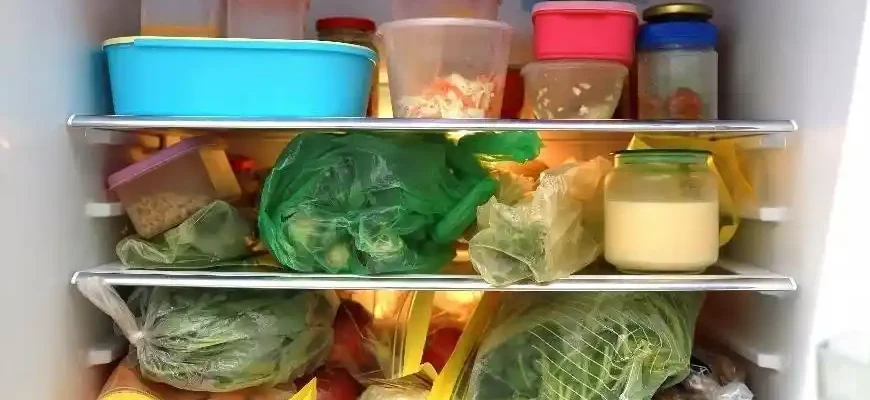Ah, the pantry. That often-overlooked, underappreciated space in your home, yet it holds the key to a smooth, stress-free kitchen experience. If you’re like most people, your pantry probably started out as an orderly haven for dry goods, spices, and cans. But over time, it likely morphed into a chaotic mess of expired pasta, mysterious boxes, and half-empty cans. Sound familiar? It’s time to take control!
In this guide, we’ll cover not just the basics of pantry organization, but the practical tips and common pitfalls that many overlook. And don’t worry, I’m not just spouting theory—I’m drawing on years of real-life experience and solid research to help you create a pantry that’s both functional and sustainable.
1. The Benefits of an Organized Pantry
Before we dive into the specifics, let’s talk about why organizing your pantry matters.
A well-organized pantry:
- Saves time and stress: No more frantic searches for that elusive can of beans in the back of the shelf.
- Helps reduce food waste: With a clear view of what you’ve got, you’ll know exactly what to use before it expires.
- Promotes healthier eating: You can see what ingredients you have on hand, making it easier to plan balanced meals.
- Saves money: When you know what’s in your pantry, you’re less likely to buy duplicates or forget about the items you already have.
But, the benefits don’t stop there. Research also shows that an organized home can positively affect your mental well-being. According to a 2016 study published in Psychological Science, cluttered spaces can contribute to feelings of stress and anxiety. Having your pantry in order can provide a subtle yet powerful sense of control in your life.
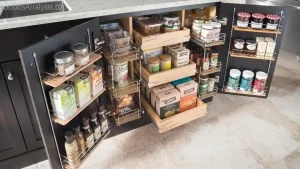
2. The Basic Principles of Pantry Organization
You don’t need a degree in interior design to organize your pantry, but there are some guiding principles to follow. Let’s break them down.
A. Categorize Everything
The first step in creating a functional pantry is categorization. By grouping similar items together, you can easily identify what you have and find what you need. Some common categories might include:
- Grains and cereals (e.g., pasta, rice, oats, flour)
- Canned and jarred goods (e.g., beans, tomatoes, sauces, jams)
- Spices and seasonings (yes, those little bottles need a home!)
- Snacks and convenience foods (chips, granola bars, crackers)
- Baking supplies (sugar, chocolate chips, vanilla extract)
B. Prioritize Accessibility
Items you use frequently should be placed at eye level, while those you use less often can go on higher or lower shelves. Consider the layout of your pantry and group items by how often they’re used. A clever trick? Place the ingredients you need for meals you make often in easy-to-reach places.
C. FIFO – First In, First Out
The FIFO method is key to avoiding expired food. This means putting newly purchased items behind older ones, so that the older items get used first. It’s a simple rule, but it can help reduce waste and save you money. To make this easier, you could use clear storage bins or labels to track expiration dates.
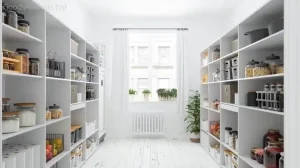
3. Storage Solutions: Containers, Labels, and More
Now that we’ve got the basic principles covered, let’s talk storage solutions. Many people make the mistake of just shoving items onto shelves without thinking about how they’ll stay organized in the long term. Here are some tips based on my experience:
A. Invest in Clear, Airtight Containers
Airtight containers are a game changer for grains, flours, nuts, and other items that can go stale. They keep your pantry looking neat and organized while protecting your food. Bonus: clear containers let you see exactly what’s inside, so there’s no digging or guesswork.
B. Label Everything
You’d be surprised how many people skip this step. Clear labels aren’t just for the visually inclined; they save you time, effort, and confusion. Use a label maker or simply stick a piece of masking tape with a permanent marker. Include the name of the item and its expiration date, and maybe even note if it’s opened or not.
C. Shelf Dividers and Bins
Pantries are often deep, which can make finding things a challenge. Consider using shelf dividers or small bins to keep smaller items grouped together. For example, you could use one bin for canned goods, another for spices, and another for snacks. It’s a simple system, but it works wonders.
D. Use the Door
Don’t forget about the back of your pantry door. A hanging organizer with small pockets can be a great place to store spices, packets of seasonings, or even small bottles of oils. It’s an often-underutilized space, and it’ll help keep everything in sight.
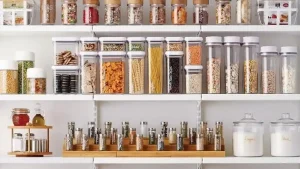
4. Avoid These Common Mistakes
Like any home project, organizing your pantry comes with its pitfalls. Here are a few mistakes to watch out for:
A. Overbuying in Bulk
Sure, buying in bulk is often more economical, but if you’re not careful, it can lead to wasted food. Large bags of flour or rice can last a long time, but if you’re not going to use them within a reasonable time frame, they can go bad or attract pests. My advice? Only buy bulk items that you know you’ll consume quickly.
B. Storing Everything on Shelves
Sometimes, people think that if it doesn’t fit on a shelf, it has no place in the pantry. But there are plenty of underutilized spaces—like the pantry floor or top shelves—where bins, baskets, and storage boxes can make a huge difference.
C. Not Maintaining Organization
It’s easy to slip back into bad habits if you don’t keep your pantry organized on a regular basis. Take 10 minutes each week to tidy up, toss expired food, and rotate stock. It’s a small effort, but it pays off in the long run.
5. Pantry Organization Around the World: Diverse Perspectives
Pantry organization isn’t a one-size-fits-all concept. Let’s look at how different people around the globe approach their pantries.
- Jin, 34, Seoul, South Korea: “In our house, we have a lot of fermented foods and pickles, so organizing our pantry means having dedicated space for jars and containers. Everything is labeled in Korean and English, and we prioritize easy access to our rice and spices.”
- Olivia, 55, New York City, USA: “I’m all about efficiency. I use glass jars for bulk items like beans, pasta, and nuts. I keep everything in its own section so I can easily find what I need when cooking. The trick is, it’s not just about organizing; it’s about keeping it that way!”
- Tariq, 47, Cairo, Egypt: “We don’t have a lot of space, so I use vertical stacking bins for cans and spices. A friend once recommended the FIFO system, and it changed my life. It’s so simple, but it keeps things from getting wasted.”
- Maria, 28, Mexico City, Mexico: “I have a small pantry, so I make use of every corner. I use mason jars for everything from sugar to chili powder. And I always keep a stash of tortillas and dried beans on hand—they’re staples!”
- Leila, 60, Paris, France: “I have a big family, so my pantry is divided into two sections: one for long-term storage and one for immediate use. Everything has its place, but the real challenge is staying on top of it!”
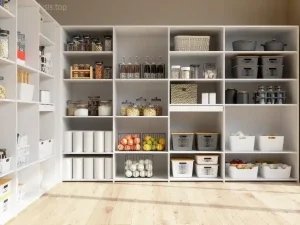
Final Thoughts: Small Steps for Big Results
An organized pantry isn’t just about looks—it’s about efficiency, ease, and reducing stress in your kitchen. By categorizing your items, investing in the right storage solutions, and avoiding common mistakes, you’ll be well on your way to a more organized and functional space. And remember, the key to long-term success is maintenance. It only takes a few minutes each week to keep your pantry in tip-top shape.
Good luck, and happy organizing!
FAQs
- How often should I reorganize my pantry?
Aim for a full pantry refresh every 3-6 months. In between, just spend a few minutes each week keeping things tidy. - How do I prevent pests in my pantry?
Keep items in airtight containers and regularly inspect your pantry for signs of pests. Clean shelves and vacuum corners to discourage them. - Can I organize my pantry without spending a lot of money?
Absolutely! Start with simple storage bins, mason jars, and labels. You don’t need fancy organizers to make a big difference.

